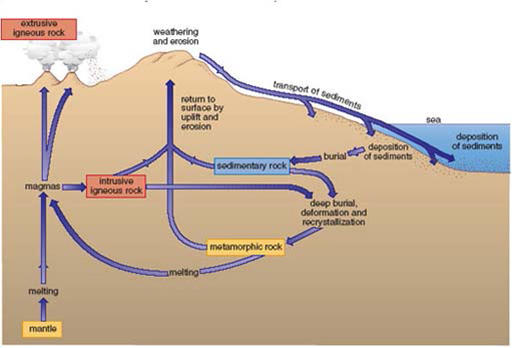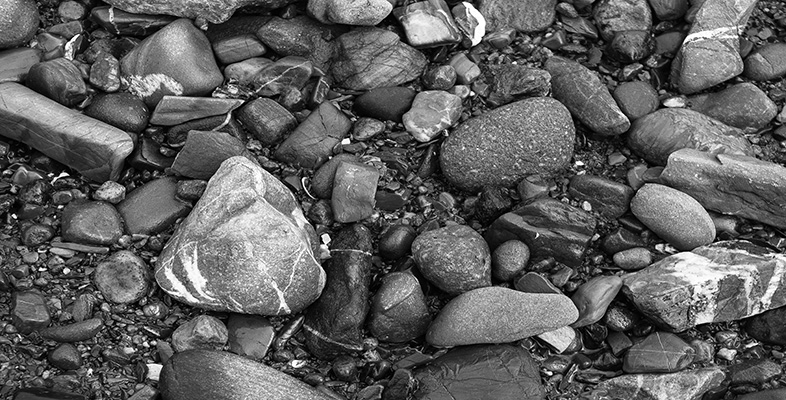1.8.1 Moving around the rock cycle
One way of illustrating the possible ways of moving material around the rock cycle is to draw a diagram that places the processes into their geological contexts. Since the rock cycle involves processes occurring on the Earth's surface and also within its interior, we use a cross-section through the Earth's crust and uppermost mantle to do this, as shown in Figure 19. In this diagram we have concentrated on the most common processes within the rock cycle.

On the grand scale of the Earth, many rock cycle processes occur at plate boundaries, where plates are created or destroyed. For example, the increases in pressure and temperature needed to cause metamorphism in the crust occur in continental collision zones. Metamorphism also occurs in the crust at subduction zones, where rocks get dragged down to great depths and hence experience great pressures. Igneous processes take place wherever melting occurs in the mantle – beneath divergent plate boundaries, above the subducting plate at convergent plate boundaries, and far from plate boundaries at hot spots.
The sedimentary processes of erosion and deposition that are important elements of the rock cycle occur in a great variety of surface environments, such as glacial environments, deserts, and continental shelves. Great rivers, such as the Nile and Mississippi, transport sedimentary material many thousands of kilometres across plate interiors, laying down fertile muddy sediments and modifying the coastline by forming deltas. Other great rivers, such as the Ganges, Indus and Brahmaputra, rise in the high mountain belts where plates are colliding. In these collision zones, plate convergence thrusts mountains into the sky, but the steep mountain slopes and high rainfall encourage weathering and erosion. Consequently, sites of mountain building generate prodigious amounts of sediment, which get washed away to be deposited elsewhere. For example, the Bay of Bengal contains several million cubic kilometres of sediment derived from the Himalayan mountains. The fate of sediments is to be eroded and redeposited, or to be turned into sedimentary rocks. Those rocks can then be caught up in subduction zones, either entering the mantle, being forced onto the edge of a continental plate, or being trapped and metamorphosed in a continental collision.
Although the rock cycle moulds the geology of the crust, it does not operate in isolation. The weathering of rock is influenced by climatic effects. The transport and deposition of sediment varies according to the strength of water currents, wind speed or glacial action. The rock cycle is also greatly influenced by organisms. An obvious example is the formation of limestones from corals and other organisms, which form calcium carbonate skeletons or protective structures. Another way in which organisms affect the rock cycle is through weathering. Rocks are partly broken down by the physical action of wind and frost, and by chemical decomposition by rainwater containing dissolved carbon dioxide, but this is greatly accelerated by plant roots, micro-organisms, and other living things in the soil.
